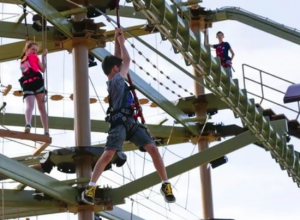
(Ozarks First)
“In the past five years, hundreds of commercial zip-line parks have opened in the United States. At least 400 are open nationwide, and more are on the way. You can zip-line across ski runs in the off-season at Hunter Mountain in New York or over giraffes at the Columbus Zoo. In Paso Robles, California, you can ride the Pinot Express zip line over the Santa Margarita Ranch vineyard. You can even zip-line in your own backyard using DIY kits from companies like Slackers and Ripline,” Outside Online reports. “As adventure parks make their way across the Pacific and open in every U.S. state, the question to ask: Is anyone regulating them?”
Following the tragic deaths of two children, WRAL reports, North Carolina “families are pushing for greater oversight for the industry that currently has very little.”
Rides at the State Fair undergo state inspections each year. So do ski lifts, elevators and moving walkways at the airport. But zip lines and ropes courses don’t get the same treatment….In North Carolina, inspections are self-regulated by the aerial adventure industry.
In July 2018, a “new ropes course at [a lodge]” was temporarily closed “after a child fell,” according to Ozarks First. The young victim was transported to the hospital in “stable” condition.
In September 2018, CBS Boston reports, Duxbury firefighters rescued a 12-year-old girl, who was found “dangling 30 feet in the air by her ankles” on a “a high angle ropes confidence course at [a local camp].”
Victims of Adventure Course Accidents: Know Your Rights
Adventure course patrons have a right to be safe and secure while enjoying the property. By law, adventure course owners have a duty to protect patrons from any foreseeable harm. This responsibility is particularly critical when overseeing the safety of children. Should an adventure course property owner fail to implement proper security precautions, safety training, or equipment inspections, they may be held civilly liable for any injuries or deaths which occur as a consequence.
 The Legal Chronicle
The Legal Chronicle

